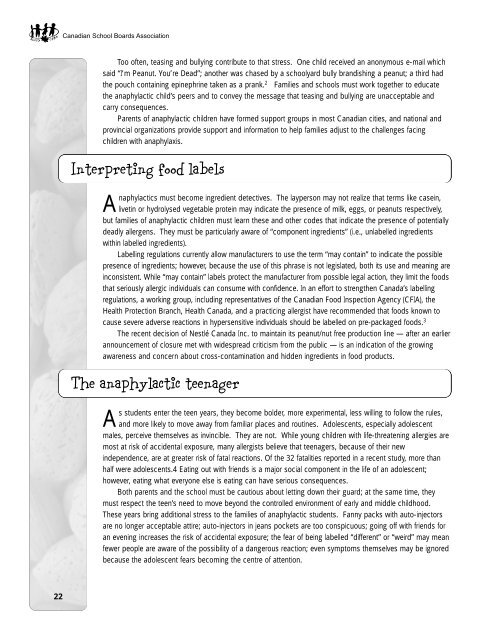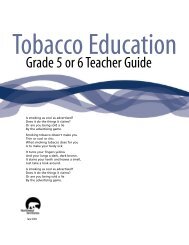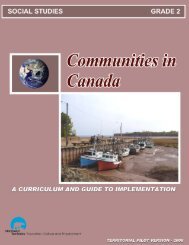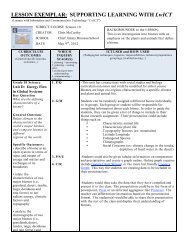Anaphylaxis: A Handbook for School Boards - Education, Culture ...
Anaphylaxis: A Handbook for School Boards - Education, Culture ...
Anaphylaxis: A Handbook for School Boards - Education, Culture ...
You also want an ePaper? Increase the reach of your titles
YUMPU automatically turns print PDFs into web optimized ePapers that Google loves.
Canadian <strong>School</strong> <strong>Boards</strong> AssociationToo often, teasing and bullying contribute to that stress. One child received an anonymous e-mail whichsaid “I’m Peanut. You’re Dead”; another was chased by a schoolyard bully brandishing a peanut; a third hadthe pouch containing epinephrine taken as a prank. 2 Families and schools must work together to educatethe anaphylactic child’s peers and to convey the message that teasing and bullying are unacceptable andcarry consequences.Parents of anaphylactic children have <strong>for</strong>med support groups in most Canadian cities, and national andprovincial organizations provide support and in<strong>for</strong>mation to help families adjust to the challenges facingchildren with anaphylaxis.Interpreting food labelsAnaphylactics must become ingredient detectives. The layperson may not realize that terms like casein,livetin or hydrolysed vegetable protein may indicate the presence of milk, eggs, or peanuts respectively,but families of anaphylactic children must learn these and other codes that indicate the presence of potentiallydeadly allergens. They must be particularly aware of “component ingredients” (i.e., unlabelled ingredientswithin labelled ingredients).Labelling regulations currently allow manufacturers to use the term “may contain” to indicate the possiblepresence of ingredients; however, because the use of this phrase is not legislated, both its use and meaning areinconsistent. While “may contain” labels protect the manufacturer from possible legal action, they limit the foodsthat seriously allergic individuals can consume with confidence. In an ef<strong>for</strong>t to strengthen Canada’s labellingregulations, a working group, including representatives of the Canadian Food Inspection Agency (CFIA), theHealth Protection Branch, Health Canada, and a practicing allergist have recommended that foods known tocause severe adverse reactions in hypersensitive individuals should be labelled on pre-packaged foods. 3The recent decision of Nestlé Canada Inc. to maintain its peanut/nut free production line — after an earlierannouncement of closure met with widespread criticism from the public — is an indication of the growingawareness and concern about cross-contamination and hidden ingredients in food products.The anaphylactic teenagerAs students enter the teen years, they become bolder, more experimental, less willing to follow the rules,and more likely to move away from familiar places and routines. Adolescents, especially adolescentmales, perceive themselves as invincible. They are not. While young children with life-threatening allergies aremost at risk of accidental exposure, many allergists believe that teenagers, because of their newindependence, are at greater risk of fatal reactions. Of the 32 fatalities reported in a recent study, more thanhalf were adolescents.4 Eating out with friends is a major social component in the life of an adolescent;however, eating what everyone else is eating can have serious consequences.Both parents and the school must be cautious about letting down their guard; at the same time, theymust respect the teen’s need to move beyond the controlled environment of early and middle childhood.These years bring additional stress to the families of anaphylactic students. Fanny packs with auto-injectorsare no longer acceptable attire; auto-injectors in jeans pockets are too conspicuous; going off with friends <strong>for</strong>an evening increases the risk of accidental exposure; the fear of being labelled “different” or “weird” may meanfewer people are aware of the possibility of a dangerous reaction; even symptoms themselves may be ignoredbecause the adolescent fears becoming the centre of attention.22
















